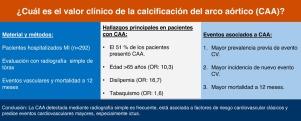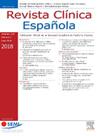主动脉钙化作为心血管危险标志的意义:对内科住院患者队列的分析
IF 1.7
4区 医学
Q2 MEDICINE, GENERAL & INTERNAL
引用次数: 0
摘要
主动脉弓钙化(aortic arch calcification, AAC)是一个被低估的心血管风险指标,与较高的主要心血管事件发生率和死亡率相关。材料和方法本回顾性描述性研究纳入了2021年5月在马奎斯瓦德西拉大学医院内科收治的292例患者。通过胸部x光片、临床数据、危险因素、既往和12个月心血管事件评估AAC的存在。结果51%的患者存在saac。65岁以上、血脂异常和吸烟是独立预测因素(P < 0.05)。AAC与较高的心血管事件发生率显著相关:卒中(23.3%比13.3%;OR: 1.9, 95% CI: 1.07-3.6)、急性冠状动脉综合征(23.3%比8.5%;OR: 3.2, 95% CI: 1.6-6.4)和外周动脉疾病(20.9%比7.3%;OR: 3.3, 95% CI: 1.6-6.9)。在12个月的随访中,AAC患者的新发心血管事件发生率更高(22.5% vs 10.9%; OR: 2.3, 95% CI 1.2-4.9; P = 0.007)。尽管该组的总生存率较低,但只有年龄和慢性肾脏疾病是死亡率的独立预测因子。结论saac在住院患者中是一种常见的发现,并与心血管风险增加有关。胸部x光检查可作为高危人群风险分层的便捷工具。本文章由计算机程序翻译,如有差异,请以英文原文为准。

Significado de la calcificación del arco aórtico como marcador de riesgo cardiovascular: análisis de una cohorte de pacientes hospitalizados en Medicina Interna
Introduction
Aortic arch calcification (AAC) is an underestimated marker of cardiovascular risk, associated with a higher incidence of major cardiovascular events and mortality.
Materials and methods
This retrospective, descriptive study included 292 patients admitted in May 2021 to the Internal Medicine Department of Marqués de Valdecilla University Hospital. The presence of AAC was assessed via chest X-rays, alongside clinical data, risk factors, and previous and 12-month cardiovascular events.
Results
AAC was present in 51% of patients. Age over 65, dyslipidemia, and smoking were independent predictors (P < .05). AAC was significantly associated with a higher prevalence of cardiovascular events: stroke (23.3% vs. 13.3%; OR: 1.9, 95% CI: 1.07-3.6), acute coronary syndrome (23.3% vs. 8.5%; OR: 3.2, 95% CI: 1.6-6.4), and peripheral arterial disease (20.9% vs. 7.3%; OR: 3.3, 95% CI: 1.6-6.9). At 12-month follow-up, patients with AAC had a higher incidence of new cardiovascular events (22.5% vs. 10.9%; OR: 2.3, 95% CI 1.2-4.9; P = .007). Although overall survival was lower in this group, only age and chronic kidney disease were independent predictors of mortality.
Conclusions
AAC is a common finding among hospitalized patients and is associated with increased cardiovascular risk. Its detection on chest X-rays may serve as an accessible tool for risk stratification in high-risk populations.
求助全文
通过发布文献求助,成功后即可免费获取论文全文。
去求助
来源期刊

Revista clinica espanola
医学-医学:内科
CiteScore
4.40
自引率
6.90%
发文量
73
审稿时长
28 days
期刊介绍:
Revista Clínica Española published its first issue in 1940 and is the body of expression of the Spanish Society of Internal Medicine (SEMI).
The journal fully endorses the goals of updating knowledge and facilitating the acquisition of key developments in internal medicine applied to clinical practice. Revista Clínica Española is subject to a thorough double blind review of the received articles written in Spanish or English. Nine issues are published each year, including mostly originals, reviews and consensus documents.
 求助内容:
求助内容: 应助结果提醒方式:
应助结果提醒方式:


